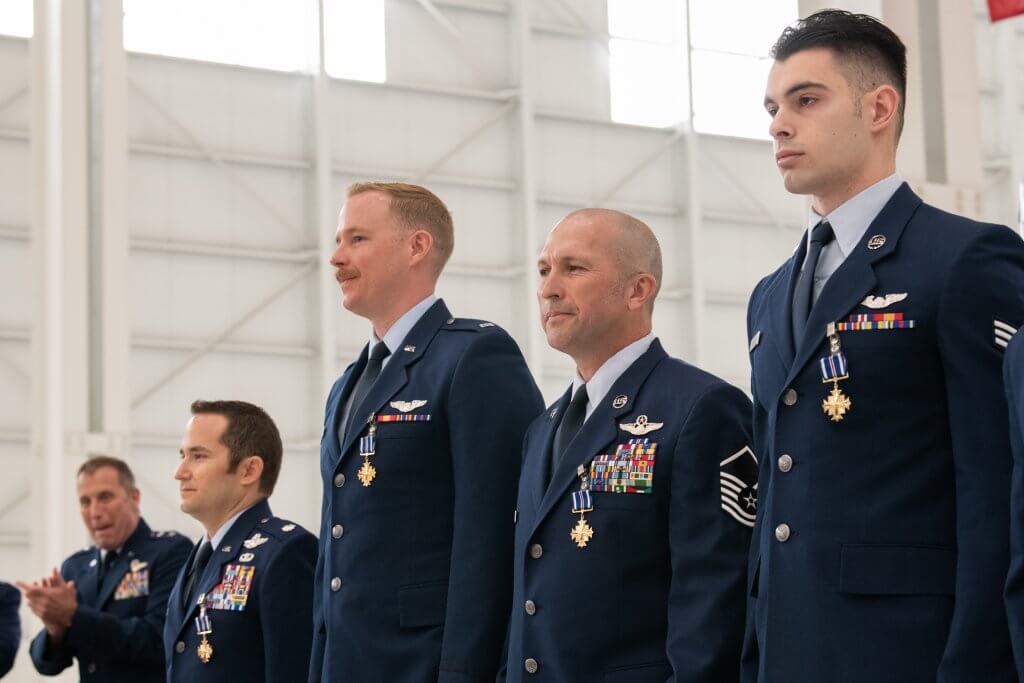After maneuvering through an aircraft traffic jam on an Afghanistan runway, a C-17 flight crew prepared for takeoff when a crowd of people “had moved onto the runway directly in front of the aircraft.”
“I pulled back hard on the control stick,” Lt. Col. Dominic Calderon said via email, recalling the events of Aug. 15, 2021, during Operation Allies Refuge. “We climbed out over the heads of the [crowd].”
In the end, the four airmen and the rest of the crew rescued 153 U.S. citizens, Afghans and allied partners. It was the beginning of the Air Force’s evacuation of more than 124,000 people from Afghanistan following the Taliban bombing of the Kabul airport.
Now, three reserve airmen manning that flight have received the Distinguished Flying Cross for their actions.
Calderon, 1st Lt. Kyle Anderson and Master Sgt. Silva Foster, of the 349th Air Mobility Wing, along with active-duty Senior Airman Michael Geller, of the 517th Airlift Squadron, were honored April 1 at a ceremony at Travis Air Force Base in California.
It was the first time a mobility airman has received the Distinguished Flying Cross since 2004, according to the Air Force.
A change in mission
The airmen were part of a C-17 crew that brought soldiers from the 82nd Airborne Division to Kabul to help secure Hamid Karzai International Airport. But their mission changed on the ground.
“We arrived at Kabul to find scores of American and allied personnel in need of evacuation,” Calderon said, “and learned that the Air Force-led portion of the non-combatant evacuation operation had begun.”
RELATED: Iowa Air National Guardsmen assist with ‘historical moment’ in Operation Allies Welcome
Calderon said he and his crew then floor-loaded personnel, which they had never done before, and created a new flight plan to a closer airport, figuring in limited fuel and altitude restrictions on emergency airlifting personnel.
One airman, Staff Sgt. Dennis Gonzalez-Furman, “hunted for fuel” but could not find it. Gonzalez-Furman also acted as a liaison “between passenger handling and the loadmaster,” according to Calderon. Alongside Foster, Gonzalez-Furman helped escort passengers back outside the aircraft to clear and safe their weapons” when said passengers began boarding “with fully loaded semi-automatic handguns and rifles,” Calderon said.
Gonzalez-Furman did not receive the Distinguished Flying Cross, but was recognized on stage on April 1.
‘Airfield was no longer secure’
Around the time all passengers had been loaded onto the aircraft, Calderon said, a tower-frequency call indicated that people were on the airfield – “alluding that the airfield was no longer secure.”
“At that point the control tower went silent,” Calderon wrote, adding that they then sealed the aircraft and started to taxi for takeoff.
Through night-vision goggles, the crew could see people entering the airfield from the civilian terminal, according to Calderon.
“To put it simply, we were bewildered by what was unfolding before our eyes,” he said, “yet determined to get the aircraft and its evacuees to safety.”
‘Memories of the feelings’
Half a century of combined experience with Foster helped the two “in keeping our wits about us and coming to quick conclusions about how best to proceed given so much uncertainty, ambiguity and rapidly changing field conditions,” Calderon said.
Calderon credited Anderson and Geller’s training and “cool demeanor” for their ability to “complete checklists and enable a safe departure from Kabul amidst constant distractions.”
For Foster, his experience as a police officer came into play throughout the event.
“I had a job to do and that was all that mattered,” Foster said.
Receiving the medal was humbling, according to Calderon, and the emotional and physical plight they witnessed among refugees was “harsh and devastating.”
“As we look back on those moments now,” Calderon said, “they aren’t so much memories of the actual events themselves, but memories of the feelings, emotions, reactions and the faces of the people that made our mission — and the entire operation last summer — possible.”

